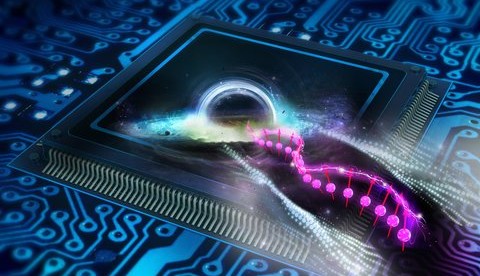Black holes on an electronic chip

Professor Rembert Duine from Eindhoven has found a way to simulate a black hole on an electronic chip. This makes it possible to study the fundamental aspects of black holes in a lab on Earth. The underlying research can also make an important contribution to quantum technology ideas. Duine and his colleagues have published the results of their research in the Physical Review Letters.
Professor Rembert Duine from Eindhoven has found a way to simulate a black hole on an electronic chip. This makes it possible to study the fundamental aspects of black holes in a lab on Earth. The underlying research can also make an important contribution to quantum technology ideas. Duine and his colleagues have published the results of their research in the Physical Review Letters.
Black holes in space are so massive that beyond the so-called event horizon nothing can escape their gravity – not even light. The researchers discovered that such a point of no return can be made for spin-waves, fluctuations that propagate in magnetic materials. When an electric current flows through such a material, the electrons drag these spin-waves along with them.
When this current is passed through a wire that is large on one end and small on the other end, then the electrons flow faster at the smaller end, and this can be fast enough that the spin-waves which are dragged along cannot return. The place where this happens is a point of no return – an event horizon for the spin-waves.
Such a point of no return on a chip makes it, in theory, possible to study the so-called Hawking-radiation (which in space is normally too weak to be observed) down on Earth. One of the characteristics of this radiation is the creation of so-called entangled particle pairs – one of the most important elements of quantum technologies such as quantum computers. 'Through this research we can make entangled pairs of spin-waves on both sides of the point of no return and use these for electronics applications', according to Duine.
Black holes in space are so massive that beyond the so-called event horizon nothing can escape their gravity – not even light. The researchers discovered that such a point of no return can be made for spin-waves, fluctuations that propagate in magnetic materials. When an electric current flows through such a material, the electrons drag these spin-waves along with them.
When this current is passed through a wire that is large on one end and small on the other end, then the electrons flow faster at the smaller end, and this can be fast enough that the spin-waves which are dragged along cannot return. The place where this happens is a point of no return – an event horizon for the spin-waves.
Such a point of no return on a chip makes it, in theory, possible to study the so-called Hawking-radiation (which in space is normally too weak to be observed) down on Earth. One of the characteristics of this radiation is the creation of so-called entangled particle pairs – one of the most important elements of quantum technologies such as quantum computers. 'Through this research we can make entangled pairs of spin-waves on both sides of the point of no return and use these for electronics applications', according to Duine.
